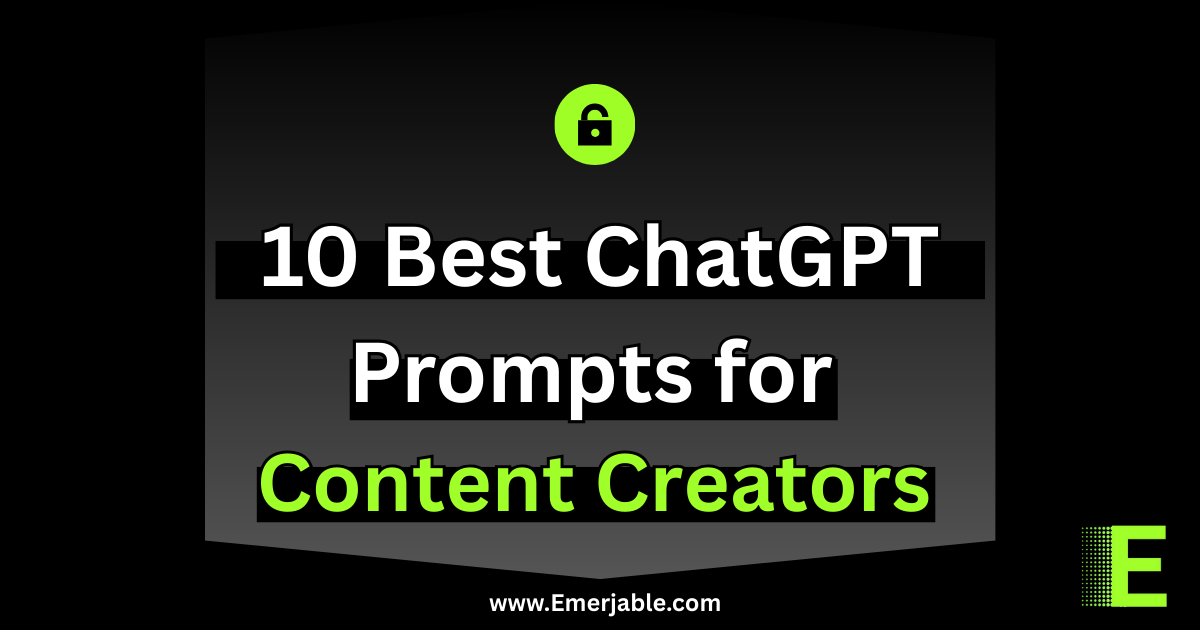Discover the best ChatGPT prompts for content creators to generate unique, engaging, and high-value content faster and easier.
1. “Create a Value-First Framework” Prompts for ChatGPT
Prompt:
You’re a content strategist. Create a value-packed framework to teach [topic] in a way that solves a common pain point for [audience].
Why it works:
It forces GPT to deliver structured, educational content with real-world application.
🧠 Example:
Create a step-by-step content strategy framework for new bloggers struggling with SEO.
2. “Case Study Creation” Prompt for ChatGPT
Prompt:
You’re a business consultant. Write a mini case study about a [industry] brand that successfully solved [problem]. Highlight the challenge, solution, and outcome.
Why it works:
Turns theory into realistic scenarios, which boosts credibility and engagement.
🧠 Example:
Write a case study of a small DTC brand that used email marketing to increase sales.
3. “Content Gap Filler” ChatGPT Prompt Example
Prompt:
You’re a content SEO expert. Analyze this topic: “[keyword]” and suggest 5 subtopics or questions that are underused in current search results. Then write an outline for one.
Why it works:
Helps you uncover low-competition opportunities with high value.
🧠 Example:
Analyze the topic “AI tools for writers” and find untapped angles.
4. “Pain-Point to Solution” Prompt for ChatGPT
Prompt:
You are a copywriter. Turn this common audience pain point: “[insert pain]” into a 500-word blog post that provides 3 actionable solutions with examples.
Why it works:
Makes content practical and immediately helpful.
🧠 Example:
Turn “I don’t know what to post on LinkedIn” into a helpful guide.
5. “Expert vs. Beginner Advice” Prompts for ChatGPT
Prompt:
You are a mentor. Compare beginner vs. expert approaches to [topic]. Explain what beginners do wrong and how experts think differently.
Why it works:
It creates insightful contrast and increases perceived authority.
🧠 Example:
Compare beginner vs. expert approaches to writing email subject lines.
6. “Explain with an Analogy” ChatGPT Prompt
Prompt:
Explain [complex concept] using a simple real-world analogy that a 10-year-old can understand. Then give a professional-level explanation.
Why it works:
Great for educational content and simplifying tough topics.
🧠 Example:
Explain “LLMs and how they work” with a kid-friendly analogy.
7. “Turn Stats into Stories” AI Prompt Example
Prompt:
You are a storyteller. Turn this statistic: “[insert stat]” into a short, compelling story that illustrates its real-life impact on [target audience].
Why it works:
Data becomes relatable, boosting engagement and retention.
🧠 Example:
Turn “70% of content gets no traffic” into a creator-focused story.
8. “Controversial but Valuable” AI Prompting
Prompt:
Write a blog post that challenges a popular belief in [industry] with evidence-backed arguments. Include actionable takeaways that offer a fresh perspective.
Why it works:
Polarizing content drives comments, shares, and loyalty—if it’s backed by value.
🧠 Example:
Challenge the belief that posting daily is necessary for growth.
9. “Prompt-Within-a-Prompt” for Expansion
Prompt:
You are a senior editor. Expand this short paragraph into a full blog post with an intro, 3 value-packed sections, a conclusion, and a CTA. Add examples where relevant.
Why it works:
Transforms rough content or notes into high-quality long-form articles.
🧠 Example:
Expand: “Personal branding is about more than just posting photos.”
10. “Reverse-Engineer What’s Working” AI Prompt Example
Prompt:
Study this viral [tweet/blog post/YouTube video] on [topic]. Reverse-engineer why it worked. Then create a similar version tailored for [my niche/audience].
Why it works:
Taps into proven content formats while staying original.
🧠 Example:
Reverse-engineer why Alex Hormozi’s content works, and apply it to solopreneur productivity.
✅ Pro Tip: Use This Add-On for Any Prompt
At the end of any prompt, add:
“Make it fresh, value-driven, and avoid generic advice. Include examples, tools, or action steps.”
This ensures GPT produces differentiated content every time.
Ref: ChatGPT

